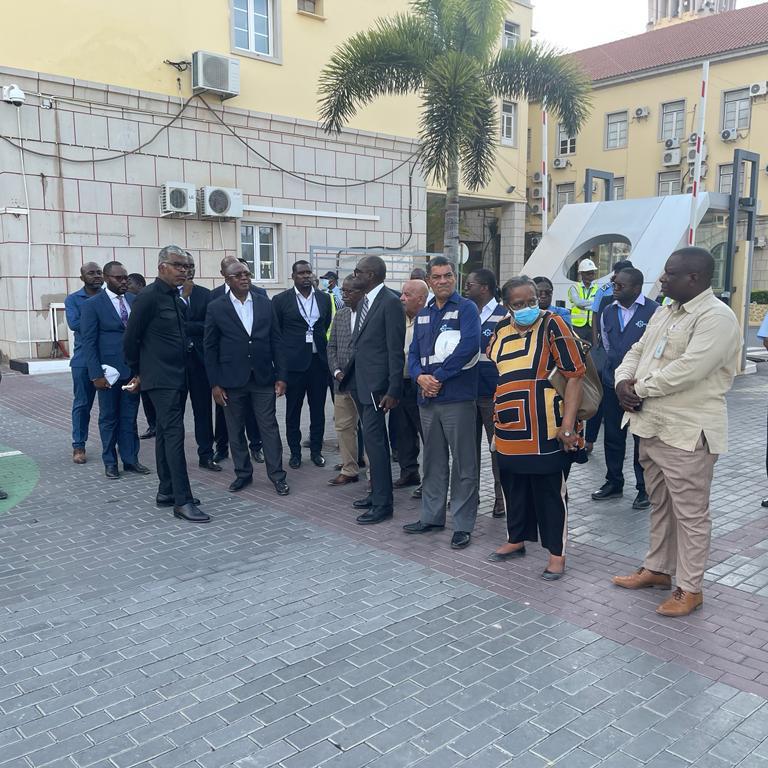The Port of Luanda
The Port of Luanda is a large-scale public corporation, endowed with administrative, financial, and patrimonial autonomy.
Privileged location
Located on the West African Coast, the Port of Luanda is the main maritime port of Angola and its most important logistical structure, where 80% of the import and export of the country is done. The Port is inserted in the center of the most populous and economically dynamic region in Angola, with easy unloading of its cargo to the countryside by the railroads and highways.
Maritime access
The Port has exceptional features that facilitate access to the sea. By being located in a naturally formed bay, it is protected from the seaside by the Island of Cabo with natural protection against currents and waves. This provides the Port with excellent conditions for maneuvering and porting of incoming vessels. Local winds and currents are weak, with peaceful and generally low tides.
Infrastructure
The Port of Luanda is 2,728 meters long and is divided into seven terminals and a logistic platform intended to aid oil & gas extraction. The Port operates 24 hours a day and the maximum draft is 13.2 m at high tide, with the depth along the quay varying between 10.5 m and 12.5 m, with the exception of the Cabotage Terminal, whose draft is from 3.5 m to 5.5 m.
Localization
The location of the Bay of Luanda, nested between the escarpment where part of the city stands, the island of Nossa Senhora do Cabo and Ponta do Dande, give the Port of Luanda its own unique characteristics and exceptional conditions that facilitate maritime access.
Operations and Services
The Port of Luanda has several terminals operated by concession and offers its customers a range of services to facilitate port operations and ensure good business is done.
Supply Water
The supplying of local potable water to the vessels is guaranteed in all terminals. An emergency supply of water can be solicited and made with a vessel not anchored to the port.
Provisions and spares
The ships anchored or moored at the port can partake in resupplying of provisions and spares, pending express approval and according to existing norms at the Port of Luanda, through specialized shipping companies.
Anchorage
Vessels can be safely anchored in the Bay of Luanda. The entrance channel is formed by firm soil, sand, and mud. Its profundity varies between 15 and 30 meters.
Piloting
Piloting is ensured by a specialized company, EPIBAL – Barra de Luanda Piloting Company. Piloting is mandatory for all national and international vessels for vessels exceeding 500 gross tonnes.
Fueling
There is an availability of heavy fuel oil and Marine HFO, fueled by Sonangol – The National Society of Fuels of Angola.
Ship Repair
There are two small spaces for repairing fishing vessels and small coastal vessels. There is also a floating dock for emergency repairs for vessels up to 6,000 Dwt.
+ Operations and Services
Ensuring customer satisfaction is a top priority. Similarly, it is equally important to expand the sources of competitive advantage, whether through improving business support processes, enhancing port operations services, or combating waste.
O porto de Luandaem tempo real
“Colaboramos com pessoas, equipes e empresas para tornar Angola um país muito mais eficiente.”
9
Terminais
42
Navios atracados
60
Navios fundeados
99
Navios esperados
Sustainability
The Port of Luanda has invested in strengthening its sustainability, competitiveness and growth through the increasing focus on modernizing its infrastructure, increasing productivity, controlling the activities of lessors and training its human resources.
News
8 de February de 2023
Port Administration trains concessionaires
On the 7th of February, training began on basic notions on safety and the environment, for the concessionary terminals of…
3 de February de 2023
Port of Luanda donates food products and school supplies
The Port of Luanda recently donated several tons of various products to the Center for Rehabilitation and Reinsertion of…
2 de February de 2023
Belgian government distinguishes PCA of the Port of Luanda
The Chairman of the Board of Directors and CEO of the Port of Luanda, Alberto Bengue, was distinguished by the government of…
20 de January de 2023
Ports of Luanda and Antwerp reinforce long-term partnership
The ports of Luanda and Antwerp-Bruges Internacional discussed the inclusion of new topics that should be included in the…
17 de January de 2023
Indians seek investment opportunities in Africa
A delegation from the Indian company Adani Ports and Logistics, India's largest commercial port operator, visited the Port…
5 de January de 2023
Minister of Transport notes progress in the work on the North Cabotage Terminal
The Minister of Transport, Ricardo D'Abreu, made a working visit on the 4th of January to verify the degree of execution of…








